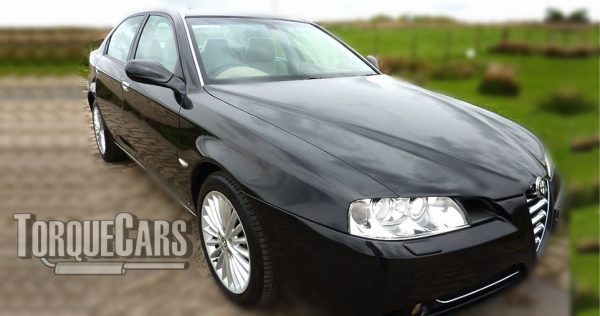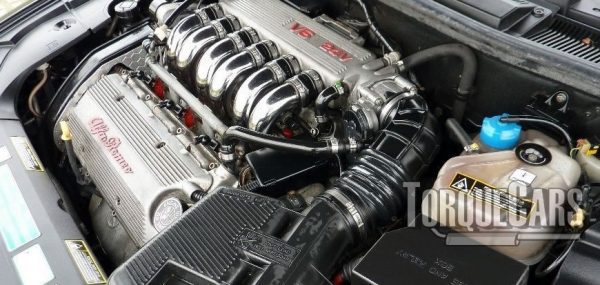Alfa Romeo 166 Tuning
"Thank you for reading my Alfa 166 tuning guide."
You can do a lot to improve the performance of your Alfa Romeo 166 with our step by step tuning tips. The key to Alfa Romeo 166 tuning is getting the right mods - a lot of money can be wasted if you do it wrong.
- 2.0 L Twin Spark
- 2.0 L Turbo V6
- 2.5 L V6
- 3.0 L V6
- 3.2 L V6
Some regions got a 2.4 JTD diesel engine as well, the 3.0V6 is our preferred engine but all the others are really good units and do very well with the right performance parts added.

Improving the handling for people often first priority in your Alfa Romeo 166 tuning project. We would go to a maximum drop of 35mm on most models. You risk rubbing on the arches if you go lower than this.
Our aim in Alfa Romeo 166 engine tuning should be to increase peak power and Torque at the top end.
The best power gains come from larger engine sizes. The more you start with the bigger the return on investment so engine swaps are good value mods for small engined cars.
Power mods.
These mods motorsport upgrades are usually carried out by our members, decide how far you want to push your car before you start.

Getting the correct grade of uprated parts for your planned usage of the car is essential. Stage 3 motor sport mods just don't work well on the road hard to control in slow traffic.
Please watch our introduction Video tutorial to car tuning. Be sure to subscribe and support our new channel.
How to tune your car
- Improve the handling
Focus on Suspension improvements, such as coilovers and make sure the bushings are in good order and that the alignment is correct. Then focus on improving the brakes, with a big disk brake conversion kit and fast road brake pads.
- Remove restrictions
Focus on the intake and exhaust with filters being the common point of restriction in a tuned car. Intercoolers may also become restrictive on turbo engines so this may also need to be uprated.
- Burn more fuel & air
Increase the fuelling so it matches the air coming into the engine. The ratio is important so you need to improve the fuel pump and injectors, so the head mods, big valve conversions, fast road camshafts and forced induction upgrades extra supply of air is adequately met.
- Test and replace any weak parts
Weak areas are commonly the clutch, the turbocharger and pistons and crankshaft in a highly tuned engine. Makes sure these components will cope with your power aspirations.
- The Tune or Remap
A cars ECU controls the fuel, timing, spark and even the turbo in some cases, so to fully extract your gains you should remap the car last and this will fully release the power. Some cars are easy to map, and others require piggyback ECU's or aftermarket ECU's but this is the most vital step of your tuning project.
Modifying to Stage 1:
Alloy wheels, Panel air filter, Suspension upgrade (drop 30-40mm), Sports exhaust, Remap, Lighter flywheel.
Modifying to Stage 2:
Fast road cam, fuel pump upgrades, high flow fuel injector, Power/Sport clutch, Ported and polished head.
Modifying to Stage 3:
Engine balancing, Sports gearbox, Competition cam, Adding or upgrading forced induction (turbo/supercharger), Internal engine upgrades (pistons/head/valves).
Your aim when tuning should be a wide torque range. You don't want all the power to be at the top end of the rev range unless you are creating a motor sport car.
In this article we shall give a little insight into the world to the best modifications for your car, but we'd encourage you to spend some time on the site looking into the details of each type of performance modification.Fast road cams offer one of the biggest performance gains for your money as far as a single motorsport upgrades goes on a NASP engine.
The intake and exhaust flow play a large part in your cars power band, but be careful here, getting this wrong can upset the idle and make the car difficult to drive in traffic. You'd need to follow a cam upgrade with other mods and finish with a reflashed ECU to fully release the power gain.Don't forget to look at the fuelling when you are increasing the power - it makes the car more thirsty.
If you find you have flat spots and surges after your motorsport mods you should check the fuelling and try a higher octane fuel as well. Uprating the injectors is another beneficial modification and will deliver sufficient fuel. If you've uprated your fuelling with bigger injectors you will also need to get a bigger fuel pump to supply it.
Intake and Exhaust Tuning.
Breathing mods are usually next up. Maximum power gains come from a full induction kit with a cold air feed on heavily tuned engines, this can be sited within an air box but a panel filter should suffice for most applications. TorqueCars suggest you use a panel air filter as these are easy to clean and maintain and generally perform better than paper ones.
Sports exhausts can usually air flow through the engine but do not go too large or you may end up will reduce the flow rate. Stick to 1.5 to 2.5 inches for best results.
Airflow through the head can be dramatically increased with some professional gas flowing. These should match and be setup to take into account any other engine mods. In nearly all cases of Alfa Romeo 166 tuning your clutch will start to slip and this needs to be uprated - read our guide on clutches for more information.
NASP engines do not achieve big power gains if you remap them, unless you have done extensive modifications.
Adding forced induction will see large power gains but this is usually too expensive to be cost effective. It is usually cheaper to bolt on a supercharger than it is to bolt on a turbo. Turbos give boost in increasing proportion to th engine speed and this can make mapping difficult.
The nice steady boost and rpm characteristics of the supercharger make them simpler to map. Decreasing the engines compression ratio will allow you to add forced induction, water injection may also help prevent detonation.
Alloy wheel upgrades.
Alloy wheels can help the brakes cool down and are generally less heavy than steel ones. The downside to large alloy wheels on your Alfa Romeo 166 is that you alter your effective final drive ratio so this will have a negative effect on performance.
Due to this fact we would advise sticking to a maximum wheel size of 17 or 18 inches, although we know some of our members have with bigger wheels with no problems.
For more information on Tuning your car please join us in our friendly forum where you can discuss Alfa Romeo 166 options in more detail with our Alfa Romeo 166 owners. It would also be worth reading our unbiased Alfa Romeo tuning articles to get a full grasp of the benefits and drawbacks of each modification.
Please help us improve these tips by sending us your feedback in the comments box below. We love to hear what our visitors have got up to and which mods work best for them on each model of car. Comments are used to improve the accuracy of these articles which are continually updated.
If you liked this page please share it with your friends, drop a link to it in your favourite forum or use the bookmarking options to save it to your social media profile.
Check out TorqueCars new YouTube channel, and see their awesome new content...
Feedback
Please use our forums if you wish to ask a tuning question, and please note we do not sell parts or services, we are just an online magazine.
Help us improve, leave a suggestion or tip
